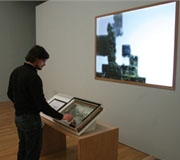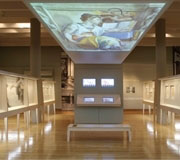Open to interpretation

Interactivity can greatly enhance art exhibitions, but only if it is integrated imaginatively into the overall experience, says Scott Billings
At Tate Britain’s preview night for Constable: The Great Landscapes, a bored, petulant looking teenager shuffles disinterestedly through almost the whole of the exhibition, only becoming attentive in the final room where there are two interactive installations. These ‘interpretive’ screens are the first major step by the gallery to introduce an interactive and interpretive dimension to visitors. Designed by All of Us, they were commissioned by James Davis, who took up the newly-formed role of assistant curator, interactive resources, in June 2004.
While their museum counterparts are now well entrenched in the world of interactivity, art galleries have been much slower to adopt. There are a number of reasons for this. Partly, it is to do with the supposedly rarefied nature of art and its appreciation, and partly, it seems, it is due to art curators’ inherent wariness of anything gimmicky. Davis, who is pioneering interactivity at Tate Britain, shares this concern and is quick to note that the starting point for any installation is an idea, not technology.
‘I’d be unhappy if we started just to assume that we will use a computer. Technology has to be subservient to our communications needs. The mistake some other museums are making is that they see the technology and think we need some of that, instead of having an idea. You must be prepared to drop technology if it doesn’t fit the idea. I’d be perfectly happy if we ended up with pencil and paper,’ says Davis.
Rachel Morris is director of content and learning at Metaphor, the exhibition design consultancy which has worked on the current Michelangelo Drawings exhibition at the British Museum (pictured below, right). With the museum’s in-house audio-visual team, Metaphor has created an overhead screen on to which the artist’s paintings are projected. Morris agrees that interactivity and technology should be approached with caution. ‘I need to be convinced each time that it’s necessary. It is a besetting sin of all interactivity that it is not integrated into the story. Then it’s a futile gesture and a waste of money,’ she says.
Another gripe that has bedeviled interactive installations is illustrated by the bored teenage boy at the Constable show – that they can appeal solely to children and those with short attention spans, often offering little in the way of genuine interactivity and learning. Instead, there is merely a screen to look at and a button to press. And, as at the Constable exhibition, ‘interactives’ are often placed at the end of the space, as an afterthought, according to Morris.
‘To be honest, there are not that many great ones around. The first generation interactives weren’t that good and the way they’re laid out is often very badly designed, but they are getting better,’ she says. ‘You’ve got to make a strong, memorable, but not too intellectual gesture [with them]. And they’re not always useful at the end of the exhibition, because then they’re not integrated into the experience.’
Nevertheless, galleries are starting to warm to the idea of interactive and interpretational elements, with the Tate Modern’s rehang two weeks ago including a dedicated Learning Zone, with interactive screens designed by Spiral Productions and integrated into an environment by Ab Rogers Design. A long-standing resistance by curators and artists to have works of art interpreted by a gallery appears to be softening, allowing designers to bring a fresh approach to communication and learning.
‘Galleries have been much slower to adapt than conventional museums, because there is a powerful feeling that art should be unmediated. But I’m pretty sure there will be more of it,’ says Morris. Tate Modern assistant curator of resources Gillian Wilson agrees. ‘There is a slightly old-fashioned view in galleries [regarding interactivity], but this is changing all the time and we’re beginning to catch up. We have made an institutional commitment to providing interpretation of some sort in all our exhibitions and displays, and we do allocate a considerable part of our budget to it,’ she says.

Wilson, who forms part of the Tate Modern’s three-strong interpretation team, says that designers have been key to the success in this area. ‘We work closely with a design team to marry both the content produced in-house and the design.’
At Tate Britain, Davis commissions designers to bring in a perspective from outside the internal team. ‘We don’t always need designers, but, by working with consultancies or individual designers, we can tap into an environment outside of the weight of the Tate institution, bringing a commercial, contemporary and fresh outlook,’ he says.
Although art galleries have been much slower than museums in taking up interactive and interpretive elements, the consensus is that this is a growth area. And those designers who are able to develop ideas beyond the information drill-down of CD-ROM-style screens are likely to benefit from this field of exhibition communication.
INTERPRETING ART:
• Metaphor and British Museum in-house audio-visual team: projections for Michelangelo Drawings: Closer to the Master (showing until 25 June)
• All of Us: interactive installations at Tate Britain’s Constable: The Great Landscapes (1 June to 28 August) and Blake and Flaxman (ongoing)
• Spiral Productions – interactive information and games in the Tate Modern’s Learning Zone (ongoing)
• Stanton Williams and Cosgrove Hall – currently designing interpretive animations for the Victoria & Albert Museum’s Leonardo Da Vinci: Experience, Experiment and Design, aiming to ‘capture the artist’s thoughts in motion’ (begins 14 September)
-
Post a comment



